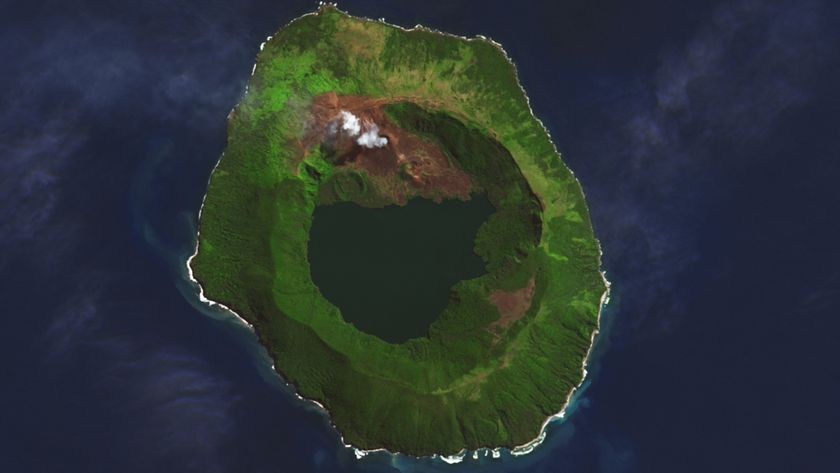Borneo Photos: Discovering the 'Other Galapagos'
Evolution’s Wonderland
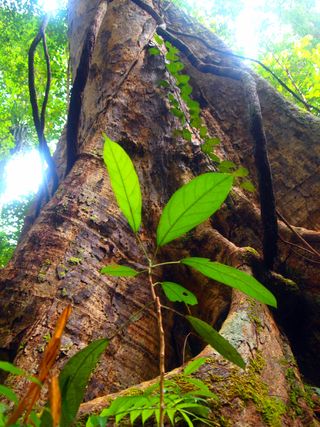
The wet, heavy heat of Borneo stirs in discontent as thunder growls and booms through pensive air. Overhead a barrage of storm clouds scrapes the roof of the jungle itself. In the dense understory a deafening hum from an incomprehensible number of insects creates an atmosphere of overwhelming fecundity.
This is Borneo: a giant equatorial island divided by three nations — Brunei and Malaysia in the north, and Indonesia in the south.
With an area covering 743,330 square kilometers (287,000 square miles) Borneo is the third largest island in the world. Surrounded by tropical seas and straddling the equator, the island contains some of the oldest rainforests and richest biodiversity on Earth. Big muddy rivers, warm shaggy jungles, monsoonal rains, time and isolation have all made it evolution's wonderland ...
The Other Galapagos
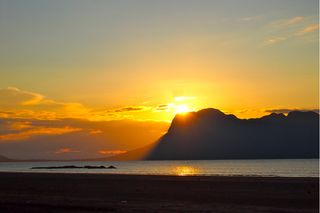
Mount Santubong (pictured) is a place that should be remembered and visited by all good naturalists. While Charles Darwin made the Galapagos famous for his discoveries that conceived the theory of evolution, Mount Santubong is a place that remains largely forgotten by history.
It was right here on the slopes of this tropical mountain by the South China Sea that Victorian explorer-scientist Alfred Russell Wallace (1823 - 1913) independently developed the theory of evolution by natural selection. Together with Charles Darwin their theory changed the way we understand the natural world, and ourselves.
While the Galapagos Islands were made famous by Darwin and have today become synonymous with evolution, Borneo, particularly southern Sarawak near the modern city of Kuching, was where Wallace collected natural history specimens and conceived his ideas of evolution. Wallace spent more time in Borneo collecting natural history specimens and observing nature than anywhere else on his eight-year journey throughout the Malay Archipelago (Singapore, Malaysia, and Indonesia).
Orangutan sighting
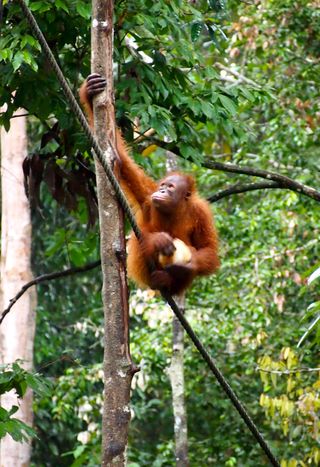
Dwarfed by the tall trees around them, a small crowd of visitors waits huddled in the rain staring up expectantly searching the treetops. Like a ripple, the rumor of an orangutan sighting begins to circulate among us. There is one out there coming our way lured in no doubt by the promise of fresh fruit placed on wooden platforms in the surrounding jungle.
As a shape becomes clear, we can see it is not one but two ginger haired apes: a mother and youngster. In the Malay language orangutan means “person of the forest.” In the language of science the Borneo orangutan is known as (Pongo pygmaeus). Most of us know them as the only Great Ape species native to Asia. They are some of our closest relatives in the animal kingdom.
Short of launching a full scale expedition into the remote jungles of Borneo, one of the most accessible ways to see orangutans in their natural habitat is to visit the Semennggoh Nature Reserve, about an hour from the city of Kuching in Sarawak.
Canopy acrobats
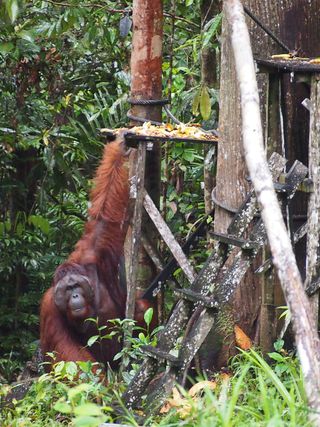
The stillness of the air is broken only by the sounds of dripping rain and quiet whispers as our group watches a dozen orangutans slowly materialize in the canopy from all directions. They cautiously descend and grab handfuls of fruit before disappearing into the branches to feast. Suddenly, we are aware of a presence: a huge male orangutan appears and all make way in his path.
This is Ritchie. At over 300 pounds, he is the alpha male and undisputed king of the reserve. He was rescued as an infant like all of the orangutans here. Since 1975 Semenggoh has accepted orphaned, injured and rescued orangutans into its 1,613 acre reserve with the aim of reintroducing them to the wild.
The orangutans are free to roam in and out of the reserve. However there is not always enough food in the forests and so they are offered fruit by the wardens. Otherwise, they are quite wild. It is estimated that only about 54,000 orangutans survive in Borneo. As tropical forests continue to be cut down for palm oil plantations, these highly endangered primates are pushed closer to extinction. Reserves like Semmenggoh go a long way to not only rescue and rehabilitate these wildlife refugees, but also educate the public about these creatures and the threats they face.
Natural Art
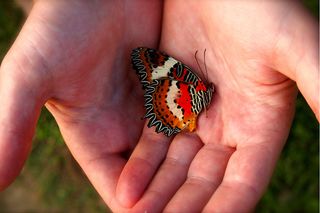
Full grown male orangutans like Ritchie are some of the largest creatures in the Borneo rainforest. Large mammals are the exception though. In the jungle it is the little things that proliferate and rule.
Borneo’s lowland forests are estimated to have over 3,000 arthropod species by some counts. Many more have yet to be discovered and described by science. From delicate lacewing butterflies (pictured) to lumbering rhinoceros beetles; venomous hairy caterpillars to gorgeous birdwing butterflies; giant millipedes to tiny termites; the insect tribe dominates the forests of Borneo.
Many of these small creatures are like beautiful works of art illustrating the wonders of evolution and biodiversity. AR Wallace’s collecting trips in Sarawak (1855) yielded the most prolific and diverse insect specimens of his whole eight year journey through the Malay Archipelago. Being surrounded by such a variety of insect specimens, it is easy to imagine how Wallace began to see the minute changes not just between species, but also within species that is the acting mechanism of evolution - natural selection.
Rafflesia
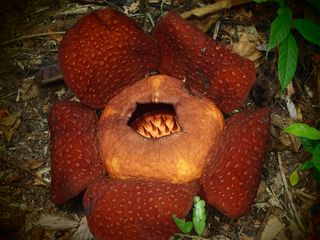
We sniff the air for putrid odors. We are told to expect a smell like rotting meat. Sweat rolls down our cheeks as we walk through a humid, windless jungle trail hemmed in by thick vegetation. It feels like a greenhouse, so perhaps it is no surprise when we finally spot the giant flowers we have been searching for: the Rafflesia, the largest flower in the world.
Rafflesias are a family of parasitic flowering plants native to Borneo and other parts of Southeast Asia. Representing over 28 species, the flowers of the largest, Rafflesia arnoldi (pictured here) can grow over 100 centimeters (39 inches) in diameter and weight up to 10 kilograms (22 lbs)! For such a massive flower it is surprising to learn that the actual plant itself is a small, parasitic vine.
Sometimes nicknamed the “corpse flower,” Rafflesia flowers have evolved to both look and smell like rotting flesh. This is not by chance, Rafflesia have evolved these traits to attract flies, their pollinators. Gunung Gading National Park, a few hours from Kuching is one of the best places in Asia to get a glimpse of these monsters of the plant world.
Frog Song
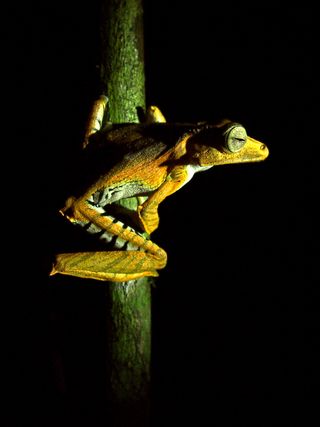
Trapezing across muddy trails and slogging up steep hillsides, we are surprised when darkness suddenly descends. As the gloom of twilight falls, loud echoing calls ring through the jungle. I cannot tell if the sounds are from an insect or a bird at first, but then realize the cacophony comes from frogs. An otherworldly symphony of haunting frog songs fills the night air. We click on our headlamps and keep moving.
Here in Kubah National Park, not far from Kuching an astounding 61 species of frogs have been documented. That’s over 1/3 of all the species found in Borneo. However, new species are being discovered all the time. In the heart of Borneo, the last frontier of the island, 600 new species of amphibians were discovered between 1995 and 2010 according to the World Wildlife Fund. That’s an astounding three new discoveries a month!
The huge number and variety of frogs is good news in an otherwise bleak forecast of amphibian decline worldwide. Breathing through their skin, frogs are highly sensitive to ecological and climate changes. This natural sensitivity makes them living indicators of the environment. By that standard the forests of Kubah must be in good shape. In one short evening we came across many species including this beautiful File Eared Tree Frog (Polypedates otilophus).
Sign up for the Live Science daily newsletter now
Get the world’s most fascinating discoveries delivered straight to your inbox.
Afraid of the dark
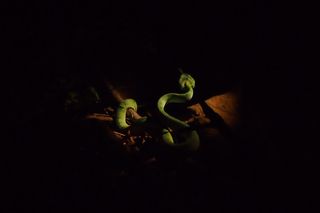
With so many frogs and other small creatures in the jungle at night, it is no surprise that there are many predators that emerge under cover of darkness to prey on them like this Wagler’s Pit Viper (Tropidolaemus wagleri), a venomous pit viper native to Borneo.
We are on a night hike in Bako National Park with local rangers. As our torches cut through the inky jungle night we search the forest floor and surrounding bush for eye shine and movement. Hemmed in by the darkness the jungle at night is a wholly different experience. As your field of vision becomes condensed to a small headlight beam, your other senses come alive. The electric hum of thousands of insects throbs in the soupy wet air.
Many creatures here are masters of camouflage. Twigs and leaves may move, transforming into leaf and stick insects. Fire flies flare up across the jungle trails. Scorpions and massive spiders crouch in dark holes. And the eye shine of roosting birds reflects back from the branches. The best encounter of the night was with a Malayan Colugo (Galeopterus variegatus), a camouflage nocturnal flying lemur that glided through the air to a tree right beside our head!
Mr. Big Nose
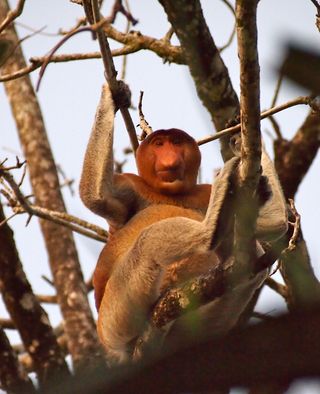
Sitting on the beach we watch twilight descend on Mount Santubong from across the peninsula. Proboscis monkeys (Nasalis larvatus) forage for leaves in the branches behind us. Looking up, we see a large male looking down his nose at us from a branch, regarding us with a somber, clown like air.
These unusual, almost comical looking monkeys are some of the most recognizable in the world with their long noses and pot bellies. Proboscis monkeys eat a variety of leaves and fruits and live in groups composed of one adult male and several females and their babies. Males grow much larger than females. The larger the nose and belly the more sexy or “fit” a male is to females.
They are endemic to Borneo and found nowhere else on Earth. These monkeys are endangered and found only around lowland forests and along rivers and swamps in coastal parts of Borneo. Just across the waters from Mount Santubong and only a day trip from Kuching, Bako National Park covers 27.27 square kilometers (10.53 square miles) at the mouth of the Kuching River. It is one of the best places in Borneo to observe these unusual primates and many other creatures.
Eternal tropics
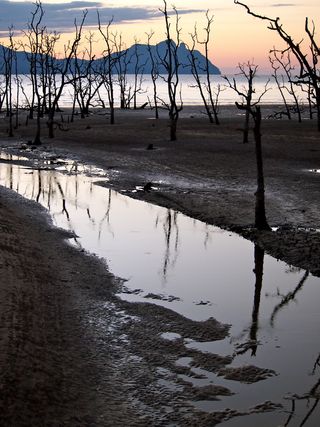
Sunset descends quickly on the equator. No long temperate summer days here; instead the rhythms of night and day are measured out in equal measure between the Earth’s hemispheres. These rhythms: of sun and moon, rainy and dry, high and low tide are ancient and have shaped and molded the plants and animals found here throughout evolutionary history in astonishing ways.
This is a place where life forms seethe: where you can meander through a forest for hours seeing plants and insects, and possibly never see the same one twice; where some of our closest evolutionary cousins still dwell in remote treetops; where giant flowers tempt passing insects with a taste for flesh; and where dazzlingly beautiful butterflies waft through the air like moving works of art. This is Borneo!
This area’s historical link to Wallace and its rich biodiversity make it very much “the other Galapagos” - an enchanting living laboratory to observe evolution and be amazed.

